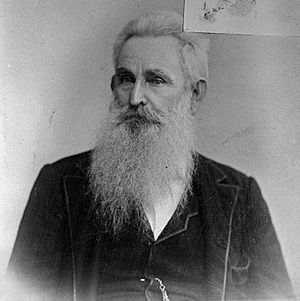Bethel Coopwood facts for kids
Bethel Coopwood (1827–1907) was an important person in American history. He was born in Alabama and later moved to Texas. He served as a soldier in the Mexican–American War and became an officer in the Confederate Army during the American Civil War. Besides being a soldier, he was also a successful lawyer, a judge, and later a historian.
Early Life and Moves
Bethel Coopwood was born on May 1, 1827, in Lawrence County, Alabama. His father, David E. Coopwood, was an early settler and planter in the area. After his father passed away in 1846, Bethel moved to Texas.
In 1847, he joined the military. He served in a cavalry group during the Mexican–American War, which took place along the Rio Grande river. By 1850, his brothers Benjamin and David had also settled in Tyler County, Texas.
Life in Southern California
In 1854, Bethel, his two brothers, and their wives moved to El Monte, California in California. There, Bethel became a lawyer and started practicing law in Los Angeles.
In 1857, he showed great bravery. After a sheriff and his team were attacked by a gang, Coopwood led a group of 26 men to help find the criminals. He was injured but still bravely charged up a hill where the gang was hiding.
Later in 1857, when he was 30 years old, he moved to San Bernardino, California. He was part of a group that bought a large piece of land called Rancho San Bernardino.
On June 15, 1859, Bethel Coopwood married Josephine Woodward, a local girl from San Bernardino. They had 14 children together. That same year, he ran for San Bernardino County District Attorney but did not win.
In September 1859, Bethel Coopwood got involved in a local dispute between two doctors. He helped protect one doctor from a group of armed men. He even sheltered the doctor in his home with the help of friends and family, including his brother David. The situation was tense, but the attackers eventually backed down.
The next day, a gunfight happened in the town streets. Bethel Coopwood and his brother David were injured during this event.
In 1860, Bethel Coopwood was involved in another court case. He was a lawyer in a dispute about election results. During the case, he had a small disagreement with the opposing lawyer but still won the case. He stayed in San Bernardino until 1861, working as a realtor and lawyer. He was good at Spanish and had many wealthy clients.
Civil War Service
In 1861, Coopwood sold his properties in California and returned to Texas with his brothers. He joined the Confederate Army as a captain in the cavalry. He served until 1863.
In 1861, he created a special cavalry unit called the San Elizario Spy Company. He led this company on important missions. He commanded Confederate forces in the Battle of Canada Alamosa and a smaller fight near Fort Thorn. During one mission, he found important water sources for the Texan Army.
Coopwood and his company were part of the New Mexico Campaign. He was sick during the Battle of Valverde but recovered to join other battles. After the Battle of Peralta, he and his Spy Company played a key role. They helped save the remaining 1,800 soldiers of the army. They found water and a safe path through difficult mountains, helping the army escape. He was later promoted to Major and then to Lieutenant Colonel before he finished his service in 1863.
Later Life and Legacy
After the Civil War, Bethel Coopwood spent a year in Coahuila, Mexico. During a dangerous trip on the Rio Grande, his brother David died. Bethel tried to get money for his brother's widow but was not successful.
He returned to Texas and became known as a skilled lawyer and a scholar of Spanish. He wrote articles and book reviews for the Texas State Historical Association Quarterly. He published historical articles like "Notes on the History of La Bahía del Espíritu Santo" and "The Route of Cabeza de Vaca."
Judge Coopwood passed away in Austin on December 26, 1907.


